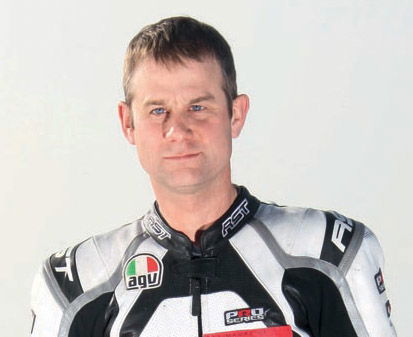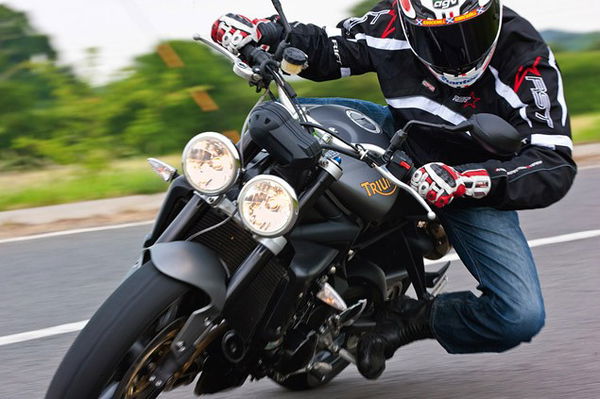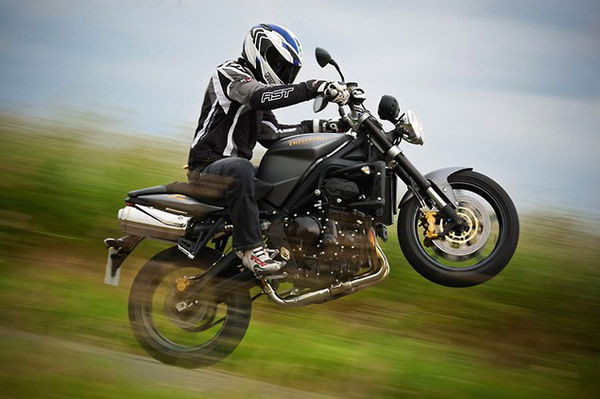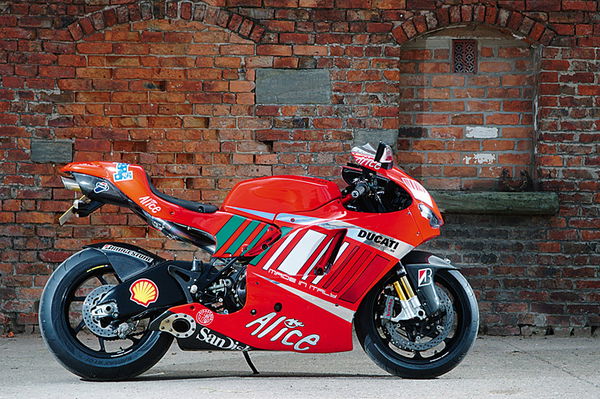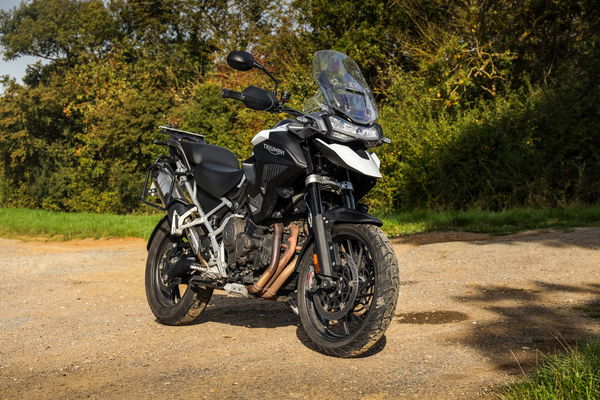Chalk & Cheese, Niall & Whit, Triumph Street Triple R & BMW F800R
Triumph’s riotous Street Triple R is the benchmark middleweight street bike, a bike so alive with character it’s arrival left big street bikes looking a little redundant. How does BMW’s new F800R compare?
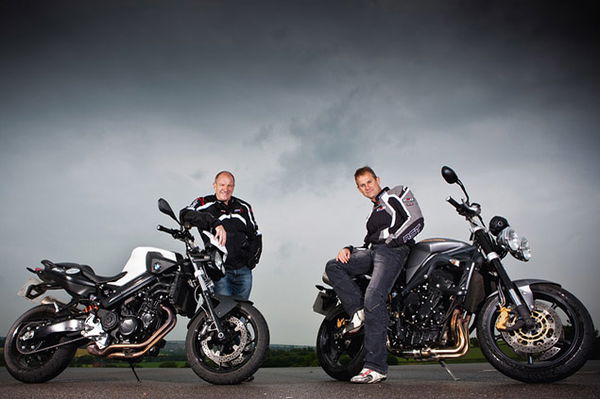

I realised a long time ago that, when it comes to motorbikes, spending more money doesn’t always mean you’ll get more fun in return. In fact, one of the most hilarious days in the history of this magazine was last year’s £200 Scrapheap Challenge. We were in stitches all day long abusing shagged bikes that simply refused to die.
Which is why, after a glut of expensive, big-capacity streetbikes on the preceeding pages, we needed a lightweight antidote in the form of BMW’s affordable and much-hyped new BMW F800R (£5925) and Triumph’s Street Triple R (£6229). Just as 600s offer an alternative to 1000cc superbikes, so street bikes like these can be more fun than their bigger siblings (more of which on p56), but can the BMW really overshadow the awesome Street Triple?
Until this test I was one of the few journalists that hadn’t spent a great deal of time with a Street Triple R but I must say I’d only ever heard and read enthusiastic reports. I’m also told that, even if you have the money, they’re as difficult to find as a Yorkshireman buying a round, so that can only be good for job security at Hinckley. I have however spent a fair bit of time on BMW’s F800-series bikes, having ridden the F800S and ST on their original launch in South Africa back in 2006.
I’ve also also thrashed them both around Donington Park and Cadwell here in the UK. I thoroughly enjoyed riding the F800S, so when I had my first look round the new naked R version I anticipated even more fun. I’ve never been a big GS or K-series fan so any BMW with a chain and a normal indicator switch is a result in my book. Yes, it does have heated grips, but then so should every new bike. Especially if it lives in Scotland.
The brief was for James and I to have some fun with these Rs, to explore their characters and to push them to the limit – same as any other test, then. And it goes without saying this was all done in a legal and safe location with risk assessments filed and medical staff in attendance.
Triumph describe the Street Triple R as being ‘harder’ than the standard model, though I must say I never thought the original was soft. To the 675-based original the R brings fully adjustable suspension and four-piston radially-mounted calipers. Both are welcome additions to a bike with this sort of engine performance – the 675 engine is re-worked for the Street Triple, with slightly less power, but it’s still a really strong motor – and the trick Magura handlebars and ‘R’ graphics help set this very minimalist bike off nicely. The bulging chrome headlights give the appearance of back-to-front 36DDs, but who’s complaining? Often simple is best so the uncomplicated appearance of this machine would suggest it’s built to do a job, rather than having lots of bells and whistles that may not be that useful on a mid-sized streetbike.
A few years ago I spent a most enjoyable year with a 675 Daytona and loved every minute. The best bit of that bike was unquestionably the sound and feel of the brilliant three-cylinder motor, so the summer of 2006 came flooding back the second the Street Triple sprung into life. Without having one alongside it’s impossible to tell if the twin pipe set-up on the Street Triple R sounds much different to the Daytona, but who cares when they both sound this good?
Triumph Street Triple R Specifications
Price: £6999
Top speed: 141mph
Engine: 675cc, 12-valve, liquid-cooled, in-line triple
Bore x stroke: 74mm x 52.3mm Compression ratio: 12.65:1
Power: 107bhp @ 11,700rpm Torque: 51 lb/ft @ 9100rpm
Front suspension: 41mm inverted forks, compression, preload and rebound adjustment
Rear suspension: Monoshock, compression, preload and rebound adjustment
Front brakes: Radially mounted four-piston Nissin calipers, 308mm discs
Rear brake: Single-piston Nissin caliper, 220mm disc
Dry weight: 167kg (367lbs) Seat height: 805mm Fuel capacity: 17.4 litres
Colour options: Orange, Grey
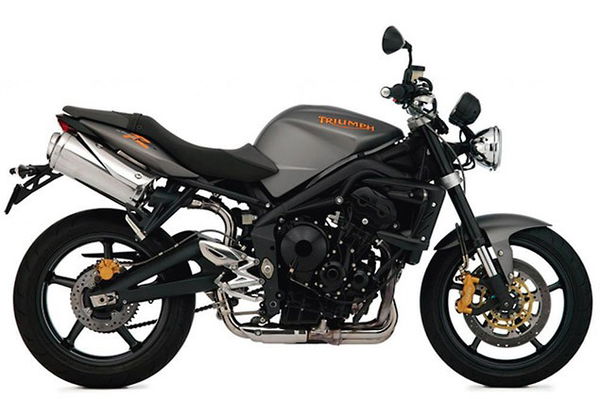
The Triumph’s seat height is slightly higher than the BMW’s (805mm versus 800mm) but the relationship between the pegs, the seat and the bars is still pretty compact, giving first rate feel and control – the bike feels tucked up on a tight ball beneath you. But while the whole bike looks and feels short, thankfully this doesn’t translate into nervous handling – accelerating just as hard as I could over bumps and cat’s eyes the bike refused to shake its head.
The rear end also stayed stuck to the tarmac – proof that the new multi-adjustable rear shock and 41mm upside-down front do a fine job. That’s not to say that the front wheel won’t come off the ground when you want it to; quite the reverse in fact. The smooth torque and flexibility of the three cylinder motor means you can perform controlled wheelies on this one all day long. In the words of James: “Bloody hell this bike is amazing – any muppet could wheelie this thing all day long.” So he did.
Like so many in the past, I could have taken Whitham’s comment as a dig at me but I’ll remain professional and turn it into a positive about the bike. What he’s trying to say is that the chassis and engine balance are spot on for wheelies, which can only make for safer and more enjoyable riding in all circumstances. With a few stunts along the way. Beautiful, controlled stoppies are just as easy; I wonder if Triumph’s test riders actually have categories for easy stunting on their evaluation checklists? I suspect they do.
In truth the Triumph’s playful poise makes you think you’re better than you probably are, but who’s complaining about that? We can all use a bike that flatters now and then, not to mention one that delivers such an addictive riding experience. With its gorgeous engine, superb chassis and aggressive riding position the standard street Triple is a blast to ride. With its appreciably better brakes and suspension for just a couple of hundred pounds more, the R is a truly brilliant middleweight street bike.
But we knew that. The question is whether the new F800R can get anywhere near the feisty Triumph. Like the Street Triple, the F800R is based on a sportsbike, albeit a slightly unconventional one, the underseat fuel tank-equipped, parallel twin F800S. The BMW’s unique packaging and design will have you circling the thing, just browsing, for ages before you finally get round to swinging your leg over the very comfy seat.
The bike has much smoother lines and contours than the chiselled Triumph, which make it somehow less masculine, but you can’t fail to appreciate the engineering of the frame, the double-sided swingarm (the F800S and ST use a single-sider) or the new exhaust. The plastics of the tank and side panels are also of excellent quality and I like the ease of the fuel filler on the right-hand side of the tail unit. But enough poking around, let’s get out there and settle this.
BMW F800R Specifications
Price: £6720
Top speed: 133mph
Engine: 798cc, 8-valve, liquid-cooled parallel twin
Bore x stroke: 82mm x 75.6mm Compression ratio: 12:1
Power: 87bhp @ 8000rpm Torque: 63 lb/ft @ 6000rpm
Front suspension: 43mm telescopic forks, no adjustment
Rear suspension: Monoshock, preload and rebound adjustment
Front brakes: Four-piston calipers, 320mm discs
Rear brake: Single-piston caliper, 265mm disc
Dry weight: 177kg (389lbs) Seat height: 800mm (775mm with low seat option) Fuel capacity: 16 litres
Colour options: White, Orange, Silver
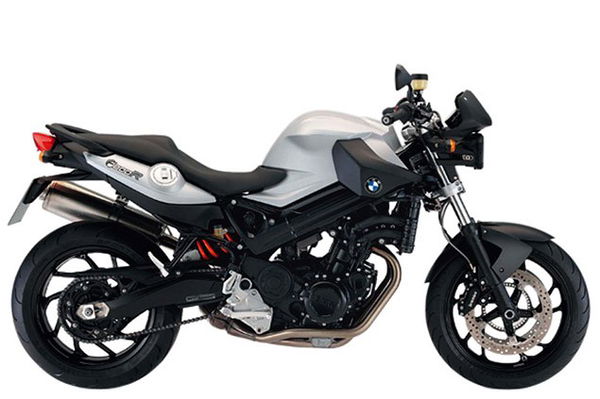
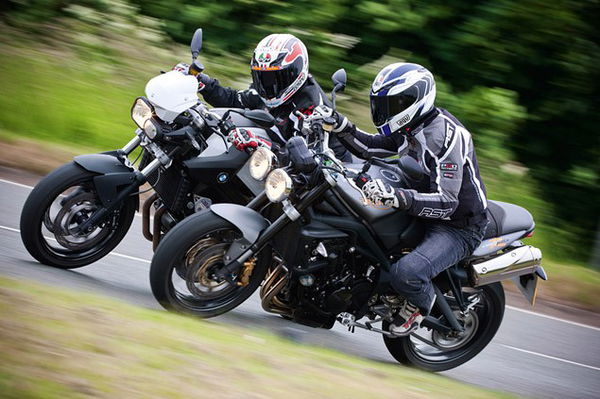
Hopping on after our first coffee break, the BMW’s engine reminds me of a bike from my dim and distant past, Yamaha’s TRX850 – remember them? While the BMW gives away 20bhp to the Triumph despite its bigger capacity (fewer cylinders mean less power and more torque), I was hoping the R’s lower fourth, fifth and sixth gear ratios and new ‘Kinematic’ throttle valve system might at least add enough oomph to keep it the fight.
Without a back-to-back test, I can’t honestly say I felt a huge difference in throttle response or acceleration when comparing it to the F800S, which itself was commendably smooth and progressive anyway. James and I both blurted out “docile” at the same time when chatting about the twin’s character. More weight and less power means the Triumph can’t help but bound ahead on the road and in truth these two machines are very different propositions.
The BMW’s radical styling suggests excitement, but it’s a pretty harmless, easy-to-ride bike. Where the Triumph feels like a genuine alternative to a sports 600, the BMW feels like it’s been designed to take Direct Access graduates by the hand and lead them into motorcycling gently. It’s the more comfortable of the two bikes – you’d happily tour on it with the optional flyscreen in place. The engine has a great bark and a nice delivery but never feels quite quick enogh, struggling while the Triumph’s triple gaps it easily.
Unlike the Street Triple, the F800R offers little scope for suspension adjustment so you’re stuck with the front fork settings. Nevertheless the bike is super-stable, ably assisted by the (unadjustable) steering damper neatly mounted beneath the bottom yoke. You can’t fault the superb Brembo brakes either and, while stunts might be out of the question, BMW’s optional ABS system is truly impressive – pull the lever just as hard as you like, safe in the knowledge you won’t lock the front. And that’s the F800R through and through. While it looks like the wild K1300R, it can’t help but be oh so sensible.
Verdict
So, which to buy? In the showroom I’d be drawn to the BMW – it’s a good-looking bike. Take them outside and fire them up and the contest evens up; the two bikes sound different but equally as good. And if you’re swung by engineering and finish, I’d go for the F800R. The design and styling are hard to fault. And on the road the BMW inspires confidence in any situation and, should you want to load it with luggage and head off for a week-long trip, the 800R wouldn’t complain.
But the Triumph has an edge in every respect. It might not look quite as classy but it is leaner and meaner, with sharper handling and superior performance. It will encourage you to ride faster but it has all the tools on board to cope with proper hard riding. Although it shares a great deal with its sibling, the 675 Daytona, the Street Triple is a very different motorcycle and every bit as wonderful. I now know what all the fuss was about with the original Street Triple and, with the R, they’ve only gone and made it better. If the R in F800R stands for racy, then the R in Street Triple R stands for Raucous, Rampant and Randy. Both are great bikes but, being an old fella, I’ll take more of the latter, thank you.
Second Opinion: James Whitham
I love the standard Street Triple and the upgraded ‘R’ is a belter Compared to the BMW the Triumph feels like a sportsbike with the fairing removed and a pair of motocross bars bolted on. It’s a lot lower at the front than the BMW, with a tighter seat-to-peg distance, but it’s still comfy enough.
The motor is a gem. There’s loads more power than the BMW, it sounds better and, contrary to the figures, it feels like there’s at least as much torque, too.
As you’d expect there’s no wind protection at all, making distances a chore, but for dodging about and having fun you’d struggle to beat it. It’s one of the best balanced bikes I’ve ever come across, with just the right mix of stability, agility, weight and power.
Apart from one or two cosmetic tweaks, the suspension and brakes are the main upgrades from the standard street Triple and, fair enough, the bike feels a little bit firmer and the radial brakes have marginally more stopping power, but is it worth the £extra? The standard bike’s a beauty.
The BMW’s riding position reminds me of a giant trail bike; hands high and wide with loads of legroom and moderately soft, compliant suspension – you’re unlikely to find a comfier bike than this. Just like the GS, you could do decent distances on the F800R without feeling like you’ve been beaten up.
It’s a very easy bike to ride generally. The light clutch and generous steering lock give you confidence at junctions, in car parks or winding your way through stationary traffic.
With its bigger engine, the BMW should be by far the gruntiest of the two bikes here but it didn’t feel it. It pulls okay, but the parallel twin isn’t the most thrilling of motors.
In the sales blurb, BMW-sponsored world freestyle stunt champion Chris Pfeiffer says the F800R “helps him come up with even more radical tricks” but our test bike came fitted with the optional ABS so most tricks, radical or otherwise, were difficult.
The F800R isn’t a bad bike. It’s well built, well equipped and dead easy to get along with. It’s a mega commuter you could use every day without thinking too much about. But for me it lacks character and is uninspiring to ride. The “smiles per mile” figure is about half of that of the Triumph.
